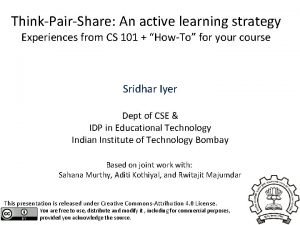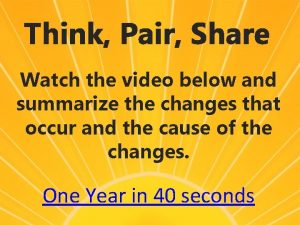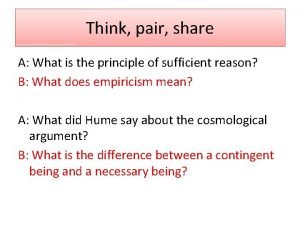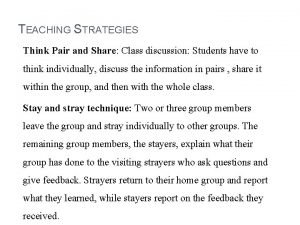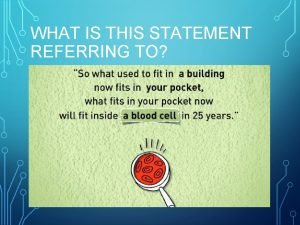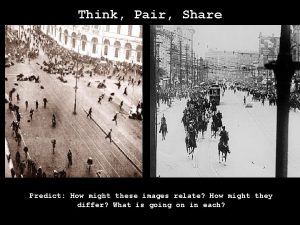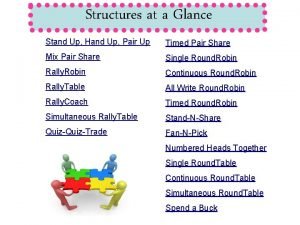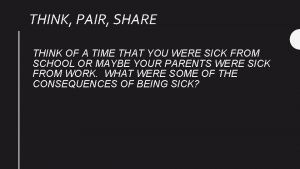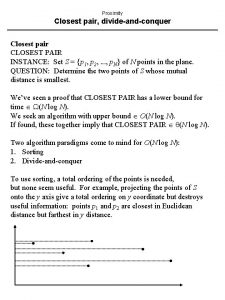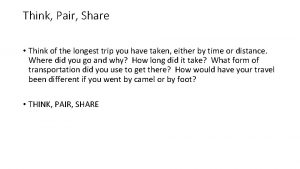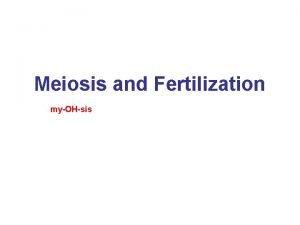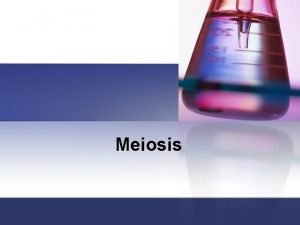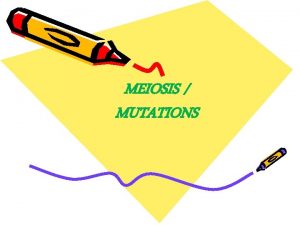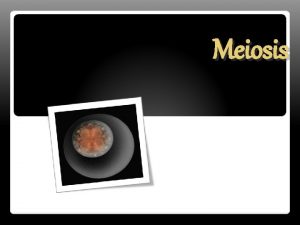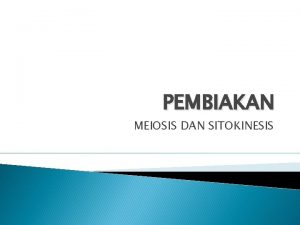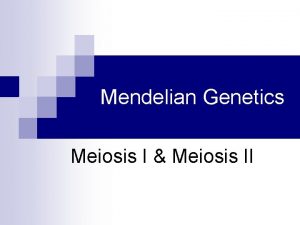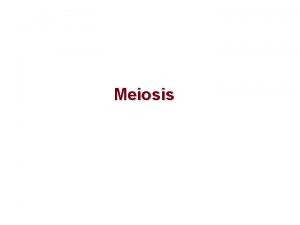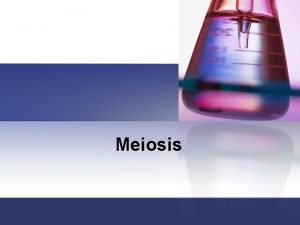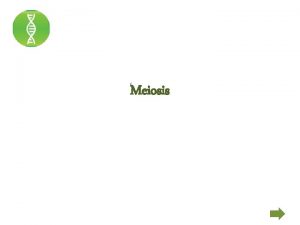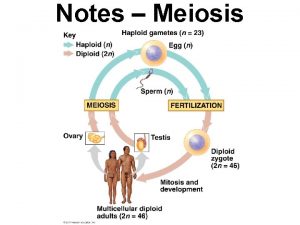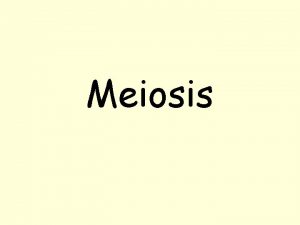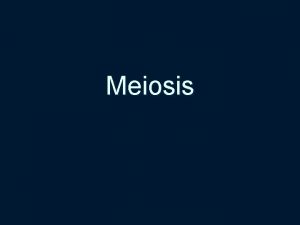Meiosis Think Pair Share Time Refresh my memory























- Slides: 23

Meiosis

Think, Pair, Share Time Refresh my memory on Mitosis Turn to your neighbor and discuss. Be prepared to share your responses. 1. What is the end product of Mitosis? Answer: 2 identical daughter cells

Think, Pair, Share Continued 2. How many phases are there in Mitosis? Answer: 4! 3. How many pairs of chromosomes do human beings have? Answer: 23 pairs (or 46 individual) 4. Why are our chromosomes arranged in pairs? Answer: because 1 comes from mom & 1 from dad

Recall Mitosis • Results in 2 daughter cells • Process has 4 stages • prophase, metaphase, anaphase, telophase and cytokinesis • Humans have 23 PAIRS of chromosomes

Remember: IPMAT!

Can that be right!? !? ! • If the end result of mitosis is two identical daughter cells, then when a male gamete(sperm) and a female gamete(egg) come together during fertilization there must be 92 chromosomes!!! Mom (23 pairs) + Dad (23 pairs) = Baby with 46 pairs!!!!

Meiosis! • Meiosis is a second round of cell division that separates sister chromatids in sex cells allowing the offspring to have the same number of chromosome pairs as their parents! Males: Sperm Females: Egg 23 chromosomes

Half from Dad, half from Mom combine in offspring for 23 PAIRS!

More on Meiosis • Meiosis allows offspring to have the same number of chromosomes as the parents (not doubled!) • Meiosis produces gametes. – Male gametes = sperm – Female gametes = egg • Gametes have ½ the number of chromosomes as the parents, so when they come together in fertilization, the offspring has 23 pairs of chromosomes. • Meiosis has 2 stages of division, not just 1 like in mitosis. • Meiosis does NOT produce identical cells

Chromosome Details Chromosomes are in pairs: 1 from mom & 1 from dad. The picture below shows 2 pairs of homologous chromosomes. This term means that the pair has genes for the same traits (in the same order)

Talking like a scientist…scientific vocabulary. • Haploid: cell containing one of each kind of chromosome (n) • Diploid: cell with 2 of each kind of chromosome (2 n)

Turn notes over! No peeking! • Quick! – How many individual chromosomes do humans have? 46 –A chimpanzee has a diploid number of 48, what is its haploid number? 24

Alleles Our traits, (hair color, eye color, height, etc. ), are controlled by genes which are located on our chromosomes. Genes exist in alternate forms – We call these different gene forms alleles. Allele Example: short/tall, brown/blonde, Example etc.

Crossing-over Crossing over results in the exchange of genetic material between homologous chromosomes. Thus increasing the genetic variation in the offspring or babies.

Crossing over results in the exchange of genetic material.

Independent Assortment • The random distribution of chromosomes during meiosis results in millions of different gametes. • This independent assortment produces millions upon millions of possible combinations of gametes for fertilization between sperm and egg.


Foundational Facts • Recall from mitosis: – IPMAT =interphase, prophase, metaphase, anaphase, telophase – Chromosome: tightly wound DNA – Sister Chromatids: two halves of the doubled chromosome structure

Meiosis Overview http: //youtu. be/D 1_-m. QS_FZ 0

Mitosis vs. Meiosis • The first five stages of meiosis look identical to mitosis…however it is the further separation of chromosomes that result in haploid gametes.

Mitosis vs. Meiosis Create which cells: Result in # of Chromosomes Haploid or Diploid? Final Result: Somatic (Body) Cells 46 Chromosomes Diploid 2 identical daughter cells (46 chromosomes each) Sex Cells (Gametes) 23 Chromosomes Haploid 4 Gametes (23 chromosomes each)

Problems in Meiosis • Nondisjunction: when homologous chromosomes do not separate normally – Can produce a gamete with an extra chromosome – Can produce a gamete that is missing a chromosome – Example: Down Syndrome (47 chromosomes)

Polyploidy • Organisms with more than the usual number of chromosome sets. • Very rare – usually results in death in animals • Common in agriculture!
 Think pair share example
Think pair share example Kagan math strategies
Kagan math strategies Pair and share activity
Pair and share activity Study jams seasons
Study jams seasons Think pair share poster
Think pair share poster Think pair share cooperative learning
Think pair share cooperative learning What are think-pair-share debates?
What are think-pair-share debates? Think pair share definition
Think pair share definition Think-pair-share advantages and disadvantages
Think-pair-share advantages and disadvantages Darlene redmond
Darlene redmond Think pair and share page 119-120
Think pair and share page 119-120 Think pair share
Think pair share Think pair and share images
Think pair and share images Dhirubhaism
Dhirubhaism Stand up handup pair up image
Stand up handup pair up image Mix pair share kagan
Mix pair share kagan Python find pairs in list
Python find pairs in list Dof of screw pair
Dof of screw pair Anaphase
Anaphase Meiosis 1
Meiosis 1 Crossing over occurs during:
Crossing over occurs during: Differences between mitosis and meiosis
Differences between mitosis and meiosis Chapter 10 section 1 meiosis worksheet answer key
Chapter 10 section 1 meiosis worksheet answer key Chapter 10 meiosis 1 and meiosis 2
Chapter 10 meiosis 1 and meiosis 2


